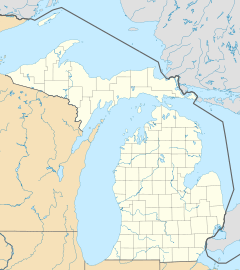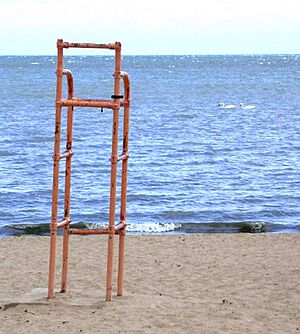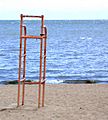St. Clair Shores, Michigan facts for kids
Quick facts for kids
St. Clair Shores, Michigan
|
|
|---|---|
|
City
|
|
| Nickname(s):
The Shores, SCS
|
|

Location within Macomb County
|
|
| Country | |
| State | |
| County | |
| Area | |
| • Total | 14.40 sq mi (37.30 km2) |
| • Land | 11.68 sq mi (30.25 km2) |
| • Water | 2.72 sq mi (7.04 km2) 18.63% |
| Elevation | 577 ft (176 m) |
| Population
(2020)
|
|
| • Total | 58,874 |
| • Density | 5,040.15/sq mi (1,946.06/km2) |
| Time zone | UTC−5 (Eastern (EST)) |
| • Summer (DST) | UTC−4 (EDT) |
| ZIP Codes |
48080, 48081, 48082
|
| Area code(s) | 586 |
| FIPS code | 26-70760 |
| GNIS feature ID | 0636601 |
St. Clair Shores is a city in Macomb County in the U.S. state of Michigan. It is a city near Detroit, located about 14 miles (22.5 km) northeast of downtown Detroit. In 2020, the city had a population of 58,874 people.
Contents
History of St. Clair Shores
St. Clair Shores is located along the shores of Lake St. Clair. French settlers first lived here around 1710. At that time, the area was called L'anse Creuse. For many years, it was mostly a rural farming area. French and German immigrant families lived there. Many of their family names are still found in the area today.
Early Townships and Changes
From 1835 to 1843, the area was part of Orange Township. This was one of the first townships in Michigan. In 1843, Orange Township was renamed Erin Township. This was to honor the many Irish immigrants who had moved there. From 1843 to 1911, what is now St. Clair Shores was part of Erin Township. Parts of Erin Township are now the cities of Eastpointe, Roseville, and St. Clair Shores.
In 1911, the eastern part of Erin Township became Lake Township. St. Clair Shores became a village in 1925. It remained part of Lake Township until 1951. In January 1951, residents voted to make St. Clair Shores a city. Lake Township continued to exist next to the city until 2009. That year, the village of Grosse Pointe Shores also became a city.
St. Clair Shores During Prohibition
Around the time of the First World War, St. Clair Shores became a popular place for fun and entertainment. This continued through the Second World War. During the time of Prohibition, when alcohol was illegal, the village had many popular places. These included roadhouses (places with food, drinks, and entertainment) and blind pigs (secret places to buy alcohol).
Because St. Clair Shores is on the lake and close to Canada, it was a good spot for rum runners. These were people who illegally brought alcohol into the country. Local people, leaders, and police sometimes disagreed with state and federal officials. They wanted to control these activities, which were important for the community's economy.
Growth After World War II
The Eagle Pointe neighborhood was planned in 1916. Many other neighborhoods were planned in the village during the early 1900s. However, most of these areas were not fully built until after the Second World War. In the 1950s, St. Clair Shores grew very quickly. It became the fastest-growing suburb of Detroit.
Jefferson Beach Amusement Park
From 1927 to 1959, St. Clair Shores was home to the Jefferson Beach Amusement Park. This was a big attraction on the lakefront for the Detroit area. It opened in 1927 and had the longest roller coaster in the United States. It also had many other rides, a large dance hall, and a sandy beach.
In 1955, a fire damaged some parts of the park. Also, people's interests began to change. The park owners thought about rebuilding. But the city council wanted to close the park or buy it for public use. Instead, the owners expanded a marina (a place for boats) that they had already started building. By 1959, the rest of the park's rides and buildings were torn down. This made room for the much larger Jefferson Beach Marina.
Geography and Location
St. Clair Shores is in the southern part of Macomb County. It is on the western side of Lake St. Clair. To the west, it borders the cities of Roseville and Eastpointe. To the south, it borders Harper Woods, Grosse Pointe Woods, and Grosse Pointe Shores. These cities are in Wayne County.
Interstate 94 runs along the western edge of St. Clair Shores. You can get on or off I-94 using Exits 224 through 230. I-94 goes southwest about 13 miles (21 km) to midtown Detroit. It goes northeast about 40 miles (64 km) to Port Huron.
The city has a total area of about 14.40 square miles (37.30 km²). About 2.72 square miles (7.04 km²), or 18.9%, of this area is water. St. Clair Shores has about 14 miles (22.5 km) of canals. Most of these canals are in an area called the Nautical Mile. This area is along Jefferson Avenue between 9 Mile and 10 Mile Roads.
Cities Near St. Clair Shores
 |
Clinton Township | Clinton Township | Harrison Township |  |
| Roseville |
Lake Saint Clair | |||
| Harper Woods | Harper Woods – Grosse Pointe Woods | Grosse Pointe Shores |
Fun Things to Do in St. Clair Shores
St. Clair Shores has many interesting places and activities.
The Nautical Mile
The Nautical Mile is a one-mile long stretch of Jefferson Avenue. It runs between Nine Mile and 10 Mile roads. This area has a nautical (boat-themed) look. You can find shops, restaurants, and places that sell boats here. There are also private and public marinas (places where boats are kept).
The tallest building in St. Clair Shores is in this area. It is the 28-story Shore Club Sky Tower. People often call it "9 Mile Tower." It is located at the end of Nine Mile Road and Jefferson Avenue, right on the lakefront. This tower is a well-known landmark. Its light on the roof can be seen for many miles.
Miss St. Clair Shores Pageant
St. Clair Shores hosts a long-running beauty pageant. It is part of the Miss America Organization. The Miss St. Clair Shores Scholarship Program has been giving scholarships to young women since 1953. Girls aged 17–24 can compete. The pageant happens every July at South Lake High School. The winner volunteers in the city and prepares for the Miss Michigan Pageant.
Music History in St. Clair Shores
St. Clair Shores has a strong connection to Detroit's music history. Many famous musicians played in the city's roadhouses. These places featured national performing artists. Other important music spots included the former Car City Records store and the Crows Nest East.
Many individuals and groups who played or visited these places became famous. These include Bob Seger, the MC5, Iggy Pop, and The Frost.
St. Clair Shores: A Hockey Town
St. Clair Shores is known as a great place for youth hockey. It was one of the first communities to be called "Hockeytown USA." This was even before the Detroit Red Wings and the city of Detroit used the name. This is because of its successful St. Clair Shores Hockey Association.
The city once had the first privately owned indoor ice hockey arena in the United States, called Gordie Howe Hockeyland. St. Clair Shores also has two public indoor ice arenas at its recreation center. Youth hockey is still very popular here. You can still see old signs saying "Hockeytown USA" inside the St. Clair Shores Civic Arena.
Why St. Clair Shores is Still Popular
Even though its population has changed, St. Clair Shores remains a popular place to live. This is because of its great location on the lake. It also has a good park system and excellent sports programs. The city has three public school districts, which are also a big draw.
Population Changes in St. Clair Shores
| Historical population | |||
|---|---|---|---|
| Census | Pop. | %± | |
| 1930 | 6,745 | — | |
| 1940 | 10,405 | 54.3% | |
| 1950 | 19,823 | 90.5% | |
| 1960 | 76,657 | 286.7% | |
| 1970 | 88,093 | 14.9% | |
| 1980 | 76,210 | −13.5% | |
| 1990 | 68,107 | −10.6% | |
| 2000 | 63,096 | −7.4% | |
| 2010 | 59,715 | −5.4% | |
| 2020 | 58,874 | −1.4% | |
| U.S. Decennial Census 2018 Estimate |
|||
What the 2010 Census Showed
In 2010, there were 59,715 people living in St. Clair Shores. There were 26,585 households and 15,932 families. The city had about 5,139 people per square mile (1,984 per km²). There were 28,467 housing units.
Most of the people in the city were White (92.7%). About 3.9% were African American, and 1.0% were Asian. About 1.7% of the population were Hispanic or Latino.
Of the households, 24.6% had children under 18 living with them. About 43.6% were married couples. The average household had 2.24 people. The average family had 2.90 people.
The average age in the city was 44.2 years old. About 19% of residents were under 18. About 19.2% were 65 or older. The city had slightly more females (52.2%) than males (47.8%).
Schools in St. Clair Shores
St. Clair Shores has three public school districts.
- South Lake Schools serves the southern part of the city.
- Lakeview Public Schools serves the central part of the city.
- Lake Shore Public Schools serves the northern part of the city.
Each of these districts has one high school within the city.
There are also private, religious schools. These include St. Germaine, St. Isaac Jogues, and St. Joan of Arc.
Famous People from St. Clair Shores
Many notable people have connections to St. Clair Shores:
- George Allen – A famous football coach. He is in the Pro Football Hall of Fame.
- Hunter Brown – A pitcher for the Houston Astros baseball team.
- Dave Coulier – An actor and comedian, known for Full House.
- David Coulter – A politician and executive for Oakland County.
- David Debol – Played for the National Hockey League's Hartford Whalers.
- Anne Fletcher – A dancer, choreographer, and film director.
- Faye Grant – An actress.
- Donald Patrick Harvey – An actor, seen in Die Hard 2.
- Alto Reed – A musician and saxophonist for The Silver Bullet Band.
- Fred "Sonic" Smith – A guitarist for the bands MC5 and Sonic's Rendezvous Band.
- Werner Spitz – A forensic pathologist.
- Mark Wells – A member of the 1980 U.S. Olympic ice hockey team, famous for the "Miracle on Ice".
- Thomas J. Wilson – The chairman and CEO of Allstate.
- John Ziegler Jr. – A former president of the NHL and a member of the Hockey Hall of Fame.
Images for kids
See also
 In Spanish: St. Clair Shores para niños
In Spanish: St. Clair Shores para niños





